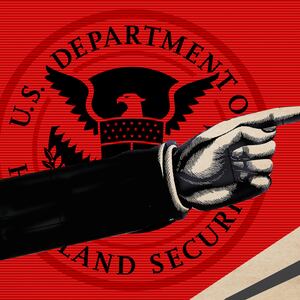The Department of Homeland Security’s decision to disband its group of domestic terrorism intelligence analysts effectively ends the agency’s role in providing assessments of white nationalist threats to law enforcement.
The elimination of a branch of the Office of Intelligence and Analysis (I&A), first reported by the Daily Beast earlier this week, resulted mainly in the reassignment of more than a dozen analysts devoted to Islamist terrorism and extremism. But it also saw the reassignment of the final two DHS experts on white nationalist extremism—just as white nationalist terrorism is clearly rising.
The reorganization, which took place last summer, was the latest, and perhaps final, step in what amounts to a dismantling of the agency’s work on domestic terrorism threats—a weakening that began under Barack Obama but accelerated under President Trump. That task is now largely limited to the FBI.
ADVERTISEMENT
“There was a little bit of life left, and that’s now been completely stamped out,” said a former DHS official who worked in intelligence. “They made a decision to get rid of the whole counter-terrorism mission of I&A.”
The diminution of DHS’s work in counterterrorism intelligence—it once regularly provided reports to local, state and regional law enforcement agencies—began a decade ago. In the spring of 2009, the non-Islamic domestic terrorism team at DHS produced a report warning of a rise in radical right terror, largely in an angry response to the election of the nation’s first black president.
Its warnings were prescient, coming just before a series of terror attacks. Among them was the murder of an abortion provider at his church; a neo-Nazi’s murder of a guard at the U.S. Holocaust Memorial Museum; another neo-Nazi’s failed attempt to murder hundreds of Martin Luther King Day celebrants; and the arrest of a man apparently plotting to bomb immigrants. The period also saw the reemergence of the often extremely violent antigovernment “Patriot” movement.
But that didn’t stop some 20 conservative groups from attacking the DHS report, falsely alleging, among other things, that it painted all conservatives and military veterans as being potential Timothy McVeighs. In the end, DHS Secretary Janet Napolitano caved in to the pressure, withdrew the report, and publicly criticized members of the team, who were reassigned to other jobs.
The ultimate result was that six of eight DHS analysts left the agency for other jobs. The two who remained were assigned to the FBI and to the network of “fusion centers” that link local law enforcement to national law agencies.
It got worse under Trump.
This is the president, after all, who while campaigning repeatedly criticized Obama for supposedly refusing to use the words “Islamic terrorism.” He is the man who proposed a ban on immigration from Muslim countries. He infamously said that there were “many fine people” among the neo-Nazi protesters who came to Charlottesville, Virginia, in 2017, and, in the wake of the recent murders of 50 Muslims in New Zealand, he said he didn’t think white nationalism was rising.
In 2017, the Trump administration seriously considered changing the name of DHS’s Countering Violent Extremism program—designed to deter terror attacks by working through community engagement and education programs—to “Countering Islamic Extremism” or “Countering Radical Islamic Extremism.”
The renaming was dropped amid widespread criticism. But the administration did rescind several key grants that had been awarded under the program, including one to Life After Hate, a group of former extremists who work to help others leave the movement, and one to a group of researchers at the University of North Carolina who were “helping young people develop media campaigns aimed at preventing their peers from embracing white supremacy and other violent ideologies,” in the words of The Atlantic’s Peter Beinart.
Despite that retreat, there isn’t much question that right-wing violence is rising.
The Anti-Defamation League reports that 71 percent of killings by extremists in the United States between 2008 and 2017 were carried out by radical rightists. The Center for Strategic and International Studies, looking at terrorism cases between 2007 and 2017, found that there were five or fewer right-wing extremist attacks each year between 2007 and 2011, but that rose to 14 in 2012 and 31 by 2017. Another study, by the Investigative Fund of the Nation Institute, found that the American radical right was behind nearly twice as many plots as Islamist groups from 2008 to 2016—115 cases versus 63 involving radical Islamists.
Hate crimes are on the rise, and so are hate groups, according to the Southern Poverty Law Center. The murder of 11 congregants of a Pittsburgh synagogue last fall, along with the slaughter of 50 Muslims at two mosques in New Zealand, are merely the latest reminders of the growing threat of the radical right.
But you’d never know that to listen to the administration.
The accused New Zealand killer wrote before his attack of hating “anti-white scum” and admiring racist murderers like Anders Breivik, who killed 77 people in Norway, and Dylann Roof, who murdered nine in Charleston, South Carolina, as heroes. He cited the white supremacist “14 Words” approvingly.
But Kellyanne Conway, in trying to suggest that the New Zealand killer was some kind of leftist, described him as a pro-China “eco-terrorist” even as she encouraged people to read the murderer’s full manifesto.
Mick Mulvaney, White House chief of staff, said that the accused killer’s 74-page screed contained “eco-terrorist passages.”
Those claims are based on a superficial reading. While the writer does show an interest in the environment, so did the original Nazis—Hitler and many others then saw themselves as protecting the environment, even if it was mainly from what they saw as the disfiguring presence of Jewish people. And the writer shows that interest in the environment in the course of making his racist motives perfectly plain.
Donald Trump has repeatedly avoided criticizing the white nationalist right, apparently not wanting to antagonize his base. He has suggested that the radical right is tiny and does not pose a serious threat.
Now, thanks to the latest changes at the agency that is meant to provide an intelligence basis for many agencies’ law enforcement work, the administration seems to be doing its best to ensure that the threat it talks down continues to swell.






